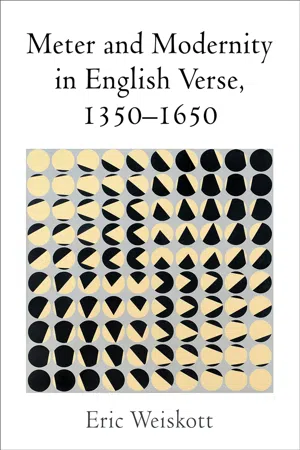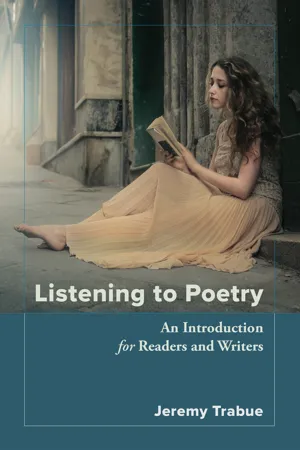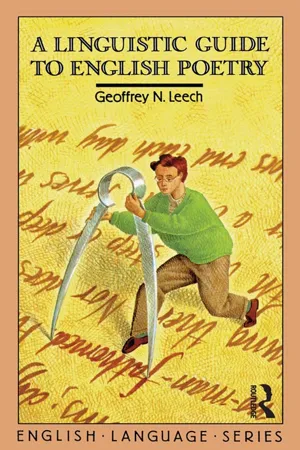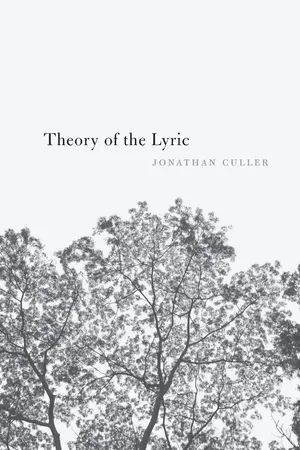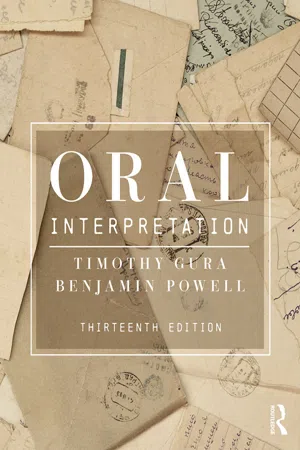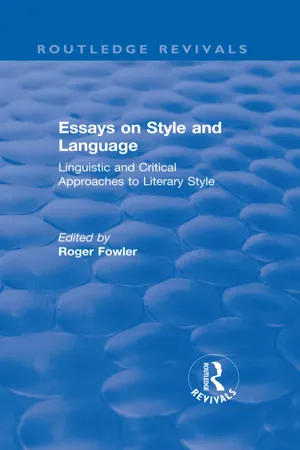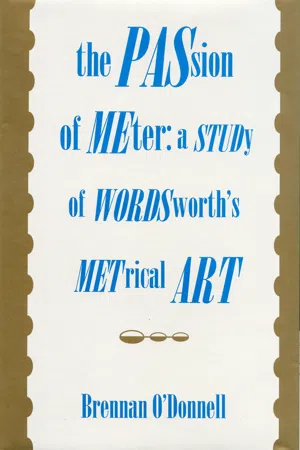Literature
Tetrameter
Tetrameter is a poetic meter consisting of four metrical feet per line. Each foot typically contains two syllables, resulting in a total of eight syllables per line. This rhythmic pattern is commonly found in various forms of poetry, including ballads, hymns, and narrative verse. Tetrameter is known for its regular and structured rhythm, which contributes to the overall musicality of the poem.
Written by Perlego with AI-assistance
9 Key excerpts on "Tetrameter"
- eBook - ePub
- Eric Weiskott(Author)
- 2021(Publication Date)
- University of Pennsylvania Press(Publisher)
mismeter and the reference to missing syllables, but also how meter and phonology could appear to him as poetic problems in the first place. Cole confirms a single basic metrical phonology connecting alliterative meter, Tetrameter, and pentameter, across lines of dialect, geography, and authorship, in the closing decades of the fourteenth century. This surprising situation, which I will argue was partly Chaucer’s doing, needs to be seen in verse-historical context.The Tetrameter entered the English literary field in the late twelfth or thirteenth century under influence from French octosyllables and Latin accentualsyllabic Tetrameter (see Chapter 4 ). By the time Chaucer set out to compose what is probably his earliest extant long poem, the Book of the Duchess (late 1360s/1370s), the Age of Tetrameter was well under way, and Tetrameter was the readiest alternative to the alliterative meter. Chaucer’s exclusive preference for Tetrameter for long poems before the Parliament of Fowls and Troilus and Criseyde has attracted remarkably little critical scrutiny.4 Yet that preference speaks volumes. Chaucer and Langland made opposite metrical choices in the 1360s, a consequence of their divergent social and geographical trajectories. Chaucer’s decision was, in part, expedient. Translating the Roman de la rose during or before work on the Book of the Duchess, Chaucer reached for the English equivalent of French octosyllables.The metrical phonology of Tetrameter reflects its medium-length history. Many twelfthand thirteenth-century word forms appeared in fourteenth-century Tetrameter. These phantom syllables no longer functioned in everyday speech and may not have been pronounced in performance, but they contributed to metrical structure as they always had. Similar phenomena, however counterintuitive, are attested in many other long-lived metrical traditions, including Ancient Greek quantitative verse, English alliterative verse, Norse alliterative verse, and modern French and Portuguese syllabic verse.5 Metrical history shapes poets’ and readers’ phenomenological experience of metrical phonology. In Chaucer’s Tetrameter, historical word forms stand in free variation with contemporary spoken forms. Compare, for example, Book of the Duchess 34 Myselven can not telle why (xSxSxSxS) and 598 Allas! and I wol tel the why (xSxSxSxS). In the first line, the infinitive verb telle counts an inflectional -e. In the second line, the -e is discounted in scansion and, as it happens, omitted in spelling. Only the first scansion, with metrically significant inflectional -e, was permissible in fourteenth-century alliterative verse apart from Piers Plowman. And so on through various classes of historical -e: the vocalic endings of Latin, Old English, Old French, and Old Norse nouns; analogical -e in historically feminine nouns; and the inflections of imperative verbs, weak and/or plural adjectives, and the preterite singular of Old English weak verbs of class I. In each case, alliterative poets cleaved to historical phonology while Chaucer and other poets writing in Tetrameter (and Langland: see Chapter 7 - eBook - ePub
Listening to Poetry
An Introduction for Readers and Writers
- Jeremy Trabue(Author)
- 2019(Publication Date)
- Chemeketa Press(Publisher)
People who think too hard about these categories disagree about whether or not a line longer than octameter is possible. At any rate, attempts at longer metrical lines are rare. It doesn’t happen in any traditional meters or forms. The most common lines in English are Tetrameter and pentameter.As you saw earlier with “iambic pentameter,” the names of the meters are just combinations of these two terms: one identifying which kind of foot the line is made of, and one identifying how many feet are in the line. If you are told that a sonnet should be written in iambic pentameter, you know that means that each line is composed of five unstressed-stressed syllable pairs—iambs. Likewise, if, in reading Poe’s “The Raven,” you notice that most of the lines are made up mostly of stressed-unstressed syllable pairs and that they tend to be sixteen syllables long, you can succinctly describe it as being “in trochaic octameter.”Should you have the chance to demonstrate an actual understanding of these concepts and terms at a party, the effect on your audience can hardly be exaggerated.Scansion
The process of examining a line or a poem in order to discover and analyze its meter is called scansion. The verb is “to scan.” Sometimes the verb “to scan” is also used to mean “composed using a regular metrical pattern.” For example, once these terms become part of your vocabulary, you might ask, “Does this line scan?” That means, “If I scanned it, would I find a basically regular pattern?”Scansion can help you identify a poem as a received form. It can also help you judge whether a poet’s attempt to write in a received form is fully successful. Other elements of a poem may also be easier to understand or appreciate once the poem’s meter has been made explicit and consciously examined through scansion.Especially if you don’t have much experience reading metrical poetry, scansion will help you fully appreciate the artistry of a poem. Reading a metrical poem without awareness of its metrical structure is like watching television with the sound off—you’re missing one of the main elements of the artist’s work. Scansion reveals that dimension of the work. It allows you to understand effects you perceived but couldn’t explain. - eBook - ePub
- Jeffrey Wainwright(Author)
- 2015(Publication Date)
- Routledge(Publisher)
iambic pentameter , and by extension other metrical lines in ways that will emphasize the importance of variation in more detail later in this chapter (see below ‘Variation in Practice’). What the basic pattern does is act as a real but often intuited structure which the practising poet may vary but never violate.There are however a number of other measures. Iambic lines might be longer and stress six of their twelve syllables making a hexameter , or, to take the name from the most standard French verse line, an alexandrine , like these translated from Pierre Corneille’s Le Cid :No day of joy or tri umph comes untouched by care , No pure content without some sha dow in the soul .Occasionally it can be even longer as in Robert Southwell ’s (c .1561–1595) ‘The Burning Babe’:As I in hoar y wint er’s night stood shiv ering in the snow , Surprised I was with sud den heat that made my heart to glow [.]Such a long line, the number of syllables make it a ‘fourteener ’, has generally been found hard to handle. A verse line needs a tension much as a washing-line does, and longer stretches can sag into incoherence. But the ‘fourteener’ has another life in which it is split into two segments in the pattern of four stress/three stress. This is also known as ballad metre or common metre that we met in Chapter 2 and is strongly associated with the oral tradition :The King sits in Dunferl ing toune Drink ing the blude -reid wine : O whar will I get a guid sailor To sail this schip of mine .Used independently, the four-stress line and the three-stress line are known as Tetrameters and trimeters respectively. Staying with iambic versions of these lines here is Jane Cave - eBook - ePub
- Geoffrey N. Leech(Author)
- 2014(Publication Date)
- Routledge(Publisher)
14 we may observe that silent stresses normally intrude themselves at the end of lines with an odd number of accents, but not at the end of those with an even number. Trimeters and pentameters, for example, have a silent stress, but not Tetrameters. If, therefore, we add the silent stress on to the number of vocalized stresses in each line, we reach the conclusion that all metres, even those apparently odd, are actually based on an even number of stresses per line. A pentameter can be regarded as a hexameter with one stress silent, and so on. The double measure (corresponding to the traditional ‘dipode’) is a basic unit of metre.To test this, read through the following extracts, and note how a pause seems to be required between trimeters or between pentameters, but not between dimeters or between Tetrameters. Again, tapping in time with the stressed syllables may aid the perception of silent stresses.Recognizing the existence of silent stresses can help us to appreciate further connections between verse and music. Just as the simpler song and dance forms of music tend to break down into four-bar, eight-bar, and sixteen-bar sections, so many verse forms are constructed out of the basic rhythm units by multiples of two. Each of the three popular metrical patterns set out below has the symmetrical structure of a square, being composed of four sections of four measures each. These sections do not in every case correspond to verse lines, which are separately indicated (by the symbol 1 ):If, as I hope, the reader has been able to decipher these formulae without too much difficulty, they may well be recognized as [a] the metre of Old Mother Hubbard, [b] the limerick metre, and [c] the popular ballad metre of The Ancient Mariner and many other poems. This way of displaying the metrical pattern shows a regularity obscured by the normal line-by-line arrangement. In more sophisticated stanza forms, this mathematical symmetry of pattern is generally less marked, but it may be part of the set of expectations we bring to English verse.Whilst on the subject of duality, we may notice that there is a curious ambivalence between single measures and double measures, which is parallel to the ambivalence of two-time and four-time in musical time-signatures. It is easy to interpret the same piece of poetry as consisting of either two measures of two syllables, or one measure of four syllables; which interpretation suggests itself most strongly is largely controlled by the speed of delivery. Kipling’s four-syllable (pæonic) metre, as we saw earlier, requires recitation at a rather fast, cantering speed: - eBook - ePub
- Jonathan Culler(Author)
- 2015(Publication Date)
- Harvard University Press(Publisher)
Even if the reading of social meanings is rather too simplistically enlisted in a story of class struggle and the triumph of the bourgeoisie, Easthope is right to link iam bic pentameter to the idea of representing the speaking subject as individual—to hearing a voice—and to associate Tetrameter with a position of enunciation not marked as that of an individual subject. Four-stress popular meters make available a collective subject position, and one joins that position as one chants or repeats: “Jack and Jill went up the hill.” We are not inclined to ask who is speaking here or to try to posit a person from the image of voice, and much of the pleasure comes from participating in that implicitly collective position. The same is arguably true of “Tyger, Tyger, burning bright, / In the forests of the night,” but not of “When in disgrace with fortune and men’s eyes.” Certainly four-stress meter can impose a certain impersonality, as in Goethe’s “Heidenr ö slein.” The five-beat line, as Attridge notes, is “a much weaker rhythmic Gestalt than a four-beat line, and is the simplest way of avoiding the much stronger rhythmic drive of four-beat verse.” Four-beat falling and triple meters are furthest from spoken English, while the line closest to the rhythms of speech is “five-beat rising duple verse or iambic pentameter.” 37 Such associational effects of meters and social meanings of rhythms vary from language to language. Comparative studies of rhythm should help illuminate the rhythmical repertoire of particular languages, identifying what we tend to think of as natural and inevitable as, in fact, a cultural construction or convention. Thus, Tarlinskaja notes that in different literatures the same general meter,… influenced by the language’s phonology and poetic traditions, assumes dissimilar forms. The topical associations and thematic preferences of the same general meter may also change, and even become opposite when adopted in different literatures - eBook - ePub
- Timothy Gura, Benjamin Powell(Authors)
- 2018(Publication Date)
- Routledge(Publisher)
feel the rhythm of a poem without being able to name it correctly as “trochaic Tetrameter.” Let’s face it: any new pursuit is likely to have terminology that seems odd at first, that takes time to master. You wouldn’t ask to be the “king” in a pick-up basketball game, and you would probably have little confidence in the mechanic who told you that your car was suffering from “a thingamajig stuck sorta near the whatchamacallit.” Technical terms provide convenient and immediate names for complex sets of information. “Iambic pentameter” calls up a rhythm, pattern, and history for students of poetry much more efficiently (and accurately) than saying, “I like it when it goes da-DUM-da-DUM-da-DUM-da-DUM-da-DUM.”Finally, of course, studying prosody asks us to account for a lot of “little” things that contribute to the awesome success of one big thing. We take it for granted in so many situations we encounter daily: something splendid often requires careful, extensive, sometimes grinding repetition—no matter how good we get at doing it. Every serious sports team presents copious playbooks, drill plans, and workout schedules—and they don’t shelve these in the closet when the team starts winning. If greatness didn’t need effort or labor, wouldn’t it be MUCH more common in all of our experiences? The way to “own” a poem is to do the (sometimes gritty) work to earn it.█ Kinds of Verse
Poems are shaped in many ways. We start by focusing on the form the poem takes when you see it on the page in front of you. Most often we see lines grouped together in clumps that we’ll call “stanza,” the “verse paragraphs” of poems. Stanzas are composed of lines, of course, so we examine the length of lines and how lines are composed. Different lines move in different ways, so we explore both the stress and the flow of sounds. Because we are always caught up by sounds, we detect how they are repeated, most obviously in rhyme. All these components of sound patterns - eBook - ePub
Routledge Revivals: Essays on Style and Language (1966)
Linguistic and Critical Approaches to Literary Style
- Roger Fowler, Roger Fowler(Authors)
- 2017(Publication Date)
- Routledge(Publisher)
What we hear in an iambic pentameter depends on one of the mass of relations within poetic form: that between two competing phonological structures. One is the metre: a skeleton with a few regularly proportioned and articulated parts. It is built up on the basis of one unit, the foot; five feet form a line; lines may be grouped into sets (‘couplets’, ‘stanzas’, etc.) by rhyme. These three units—foot, line and stanza—are identified by phonetic characteristics. The foot has a light followed by a heavy stress; within the line, all light and heavy stresses are equated, giving only two grades of stress. The line is marked off, not only by the number of feet, stresses and syllables it contains, but by certain terminal sound-features: perhaps by a pause, but more probably by a prolongation of its last vowel and/or voiced consonant; often by a change in the pitch of the voice. The stanza is identified by its rhyme-scheme and often by a fall in the pitch of the voice at the end. Some other minor conventions govern the form of the pentameter: for example, the light and heavy stresses of the first foot may be reversed (but not too often); the stresses of the second foot may not.This metrical skeleton has to be filled out by linguistic elements—grammatical and lexical units—which have their own expectations of phonological form: ‘prose rhythm’, the second of the structures I have referred to. English grammar, like English pentameter metre, has a scale of units of different ‘sizes’: morpheme, word, phrase, clause, sentence, in ascending order of magnitude. These units of grammar have their own stress-patterns which—and this is the whole point of this essay—may or may not correspond with those of the metrical matrix that they are made to occupy. The ends of sentences are inevitably marked by a change in the pitch of the voice; no matter how this is interpreted by different performers, it must occur in some form. Now the sentence is a unit of great variation in length, so the ‘terminal juncture’, as the end-marker is called, may or may not fall in the same places as the natural terminal junctures of the metre: at line- and stanza-ends. The smallest unit in the metre is the metrical point: it is always′ or× ; any two in sequence are likely to be different; the order in which they combine to make up a foot is almost always× ′. The smallest unit in the grammar is the morpheme. It is most often a monosyllable, and may have any one of four stresses:’, ^, ′, or ˇ in descending order of loudness.3 The selection depends on the adjacent stresses, and these in turn are governed chiefly by the grammatical construction in which the morpheme occurs. Greenfly has”; green fly ˆ ’ apart ˇ ’ -itab - in inevitable ’ˆ - eBook - ePub
The Passion of Meter
A Study of Wordsworth's Metrical Art
- Brennan O'Donnell(Author)
- 2011(Publication Date)
- The Kent State University Press(Publisher)
Metrical poetry in Wordsworth’s view invites—even requires—rereading in part because it keeps the mind constantly and actively aware that any single reading is “a” reading. In its encouragement of dual perception of the same order of words, it encourages a kind of oscillation of mind which in turn helps create a feeling that the resources of the line or passage are never entirely exhausted by a single reading. By allowing the mind to hover between competing alternatives in the realization of a line or passage, regular meter allows the language of the poem to be perceived as alive with possibility and potentiality: the dead letter, well versified, is revived in each new performance of the verse. Emphasize the “prose pattern” (or what Thelwall calls the emphasis required by the “grammatical construction” alone) of any complex instance of the kind of verse that Wordsworth describes and the metrical set will intrude upon the reading; sing it in perfect accord with a fixed idea of order and its recalcitrancies as a language in everyday use will work against the regularizing impulses. Without a metrical context, one might read thus:Once the line is recognized as conforming to a recognizable verse pattern, whether it is called a “four beat line in rising rhythm” or “iambic Tetrameter,” the possibility of the following singsong reading is registered at some level of the reader’s consciousness:A good metrical reading will provide a “complex feeling of delight” through “an indistinct perception perpetually renewed of language closely resembling that of real life, and yet, in the circumstance of metre,” and in this case end rhyme, “differing from it so widely” (Prose 1:151). One may read the line expressively thus:But because of the metrical set, the excluded possibilities will still hover around the line. Placed significantly in an offbeat position, the syllable “leaps” dislocates the verse, and contributes obviously to its expressive force. In a poem about the speaker’s paradoxical wish to have the continuity of his life founded on a sustained ability to make a break with the order of things, such invocation of a scheme through a “dislocation” of it may also be regarded as emblematic of the ways of “natural piety.” In John Hollander’s terms, what was merely a “scheme” or conventional pattern can become, at such points in the verse, a trope. - eBook - ePub
Verse
An Introduction to Prosody
- Charles O. Hartman(Author)
- 2015(Publication Date)
- Wiley-Blackwell(Publisher)
Anapests, with just one stress in three syllables, go the other way, toward relaxation. Furthermore, a series of anapests in a row produce a “runaway horse” effect – sentences galloping recklessly over whatever they try to communicate – that tends to drown out any subtler music. Poets are wary of these “triple threats to duple rhythm,” as the critic Edward Weismiller has called them. (A duple rhythm is one based on a two-syllable foot like the iamb.) If a line has a string of especially light stresses – “I do not at this point in time agree” – it can be all too easy to hear and scan as an anapestic Tetrameter: x x / | x x / | x / | x / (?) I do not at this point in time agree (This is a made-up bad example; poets avoid this kind of uncertainty in meter.) The solution, when scanning a line, is to remember to hold the number of feet in the line constant. The Persistence of Line Length If the poem begins in iambic pentameter, expect every line to have five feet. (Remember that the double iamb counts as two.) What the five feet are can vary, but not their number. It’s useful to think of this rule as absolute: when you’re scanning a poem in iambic pentameter, always check to make sure every line has five feet, not four or six. These are easy mistakes to make. You’ll encounter two kinds of exceptions to this rule. First, when lines are collected into stanza forms (which we’ll discuss in Chapter 3), those repeated stanzas may systematically vary the number of feet in particular lines. The Spenserian stanza, for example, is eight iambic pentameters followed by one iambic hexameter. Keats’s “Ode to a Nightingale” is mostly in iambic pentameter, but he shortens the eighth line of each stanza to an iambic trimeter. Second, in the period when iambic pentameter dominated English poetry most thoroughly – roughly, the “long Eighteenth Century” – an accepted source of variety was to introduce an occasional hexameter
Index pages curate the most relevant extracts from our library of academic textbooks. They’ve been created using an in-house natural language model (NLM), each adding context and meaning to key research topics.
Explore more topic indexes
Explore more topic indexes
1 of 6
Explore more topic indexes
1 of 4
